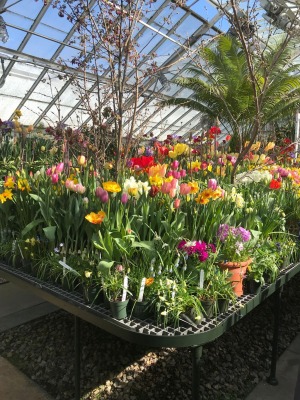Terrific Terrariums
How to Make a Terrarium
By David Stender - WGC President (2021-2023)
 I attended a terrarium-making workshop at my local
greenhouse years ago before moving to Connecticut. I ended up making several closed terrariums and gifted them to family members. About eight years later, I’m making another
round of these small plant gifts to replace what lasted many, many years longer
than I anticipated.
I attended a terrarium-making workshop at my local
greenhouse years ago before moving to Connecticut. I ended up making several closed terrariums and gifted them to family members. About eight years later, I’m making another
round of these small plant gifts to replace what lasted many, many years longer
than I anticipated.
A closed terrarium is one in which there is a lid that
captures the moisture in the container through evaporation, and the enclosed
system gets all the rain it needs.
Once established, you don’t need to water this type of terrarium. One key thing to keep in mind is that I have found that closed terrariums should not be placed in direct sunlight. Near a bright sunny window is OK, but no direct sunlight. The large apothecary jar terrarium I gave my parents lasted for nearly eight years and got bright sun in the morning (but not direct sun).
An open terrarium is perhaps a nice way to start this
craft. There is no lid on such a terrarium; you need to water it occasionally—like a regular houseplant. You can get away with a bit more light and some direct sunlight, but remember how small the soil area is and how quickly
such a small plant can dry up.
How to make a terrarium:
Container size: Remember
that nearly one-third of the container will be filled with material. You also
need some space for the plant(s) to grow! The wider the container, the more plants you can include in your mini ecosystem.
I tend to use apothecary jars given their shape – at
their widest point is where the plants can grow, and their lids work perfectly
to keep the water inside the closed terrarium. Given the container's shape, you also don’t have to use as much material on the bottom. I’ve also used wide
fishbowls and other glass container shapes. Keep in mind that the lid must not
be porous like wood. Choose glass or solid material. Otherwise, you will grow
mold instead of plants.

Materials in this order: Small
pebbles (I used small rocks from a fish store for an aquarium), small/crushed
lava rocks, small/crushed charcoal, moss, and soil. I sometimes skip the
charcoal, but the lava rocks are important to include. I typically top off the
edges of the soil level with some decorated rocks. Avoid plant placement where
the leaves will touch the glass container.
Give them some space to grow. If making a closed terrarium, put in half
as much water as you think you should before placing the lid on. A little bit
goes a long way- trust me. Monitor the
plants, particularly the leaves, for mold (that means you have too much
moisture in the container; take the lid off completely or at least place it
ajar.
with some decorated rocks. Avoid plant placement where
the leaves will touch the glass container.
Give them some space to grow. If making a closed terrarium, put in half
as much water as you think you should before placing the lid on. A little bit
goes a long way- trust me. Monitor the
plants, particularly the leaves, for mold (that means you have too much
moisture in the container; take the lid off completely or at least place it
ajar.
Plants: You want to
select a variety of tiny plants. They typically range in price from $3 to $5
each. Think about the plant size for your terrarium: Some plants grow more vertically and are slender, while others don’t grow particularly high but can expand at their width. If you're putting in multiple plants, consider opposing textures and colors. There are some really great variegated varieties and even some leaves that are red, purple, and other contrasting colors to the range of
green found in most plants.
opposing textures and colors. There are some really great variegated varieties and even some leaves that are red, purple, and other contrasting colors to the range of
green found in most plants.
My sister gifted me a terrarium tool kit a few years
back. The shovel with a long handle came in handy during my recent terrarium-making session.
Tip on lava rocks:
I purchased a bag at my local large hardware store (in the section near the
outdoor gas fire pits). I then crushed
the rocks with a hammer and many layers of plastic bags to contain the rocks.
Use the same method to crush charcoal.
Happy planting!


| ||||||||||||||||||||||||||||||||||||||||||||



